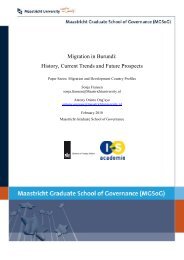Migration in Morocco: History, Current Trends and Future ... - MGSoG
Migration in Morocco: History, Current Trends and Future ... - MGSoG
Migration in Morocco: History, Current Trends and Future ... - MGSoG
You also want an ePaper? Increase the reach of your titles
YUMPU automatically turns print PDFs into web optimized ePapers that Google loves.
discrim<strong>in</strong>ation. Giv<strong>in</strong>g young men the opportunity to work abroad <strong>and</strong> earn good money<br />
was seen as a means to reduce rebellious tendencies <strong>and</strong> contribute to prosperity (de Haas,<br />
2007a). Those early departure zones of <strong>in</strong>ternational migration have also been the regions<br />
with established traditions of seasonal <strong>and</strong> circular migration with<strong>in</strong> <strong>Morocco</strong> <strong>and</strong><br />
towards Algeria.<br />
The Sous is a dry region <strong>in</strong> which traditional economic activities are based on<br />
different irrigation technologies, <strong>and</strong> it is <strong>in</strong>habited mostly by a Berber population<br />
(Berriane <strong>and</strong> Aderghal, 2008). Next to the strong tradition of <strong>in</strong>ternal migration, the<br />
Soussi migrated to Algeria very early <strong>and</strong> later on oriented their migration activities<br />
ma<strong>in</strong>ly to France, the former colonizer. <strong>Migration</strong> from another important Moroccan<br />
send<strong>in</strong>g region, the Saharan oasis, has been ma<strong>in</strong>ly oriented towards France <strong>and</strong>, to a<br />
small extent, to the Netherl<strong>and</strong>s <strong>and</strong> Belgium. Moreover, cities of Atlantic <strong>Morocco</strong> were<br />
dest<strong>in</strong>ations (de Haas, 2007b). Both the Sous region <strong>and</strong> the oases southeast of the Atlas<br />
belong to areas where <strong>in</strong>habitants were relatively <strong>in</strong>dependent from the sultan’s power<br />
prior to colonization <strong>and</strong> tribes were only dom<strong>in</strong>ated by state power <strong>in</strong> the 1930s (de<br />
Haas, 2007a). This expla<strong>in</strong>s the concern for political tensions <strong>in</strong> these areas <strong>and</strong> the<br />
government’s <strong>in</strong>tention to stimulate migration from those regions.<br />
The Rif area is, from a quantitative po<strong>in</strong>t of view, the most important region for<br />
migration to Europe. This very densely populated <strong>and</strong> dry rural region was colonized by<br />
the Spanish, <strong>and</strong> the population thus does not generally speak French. <strong>History</strong> helps<br />
expla<strong>in</strong> why migration from the North East of <strong>Morocco</strong> was ma<strong>in</strong>ly directed towards the<br />
Netherl<strong>and</strong>s, Germany, <strong>and</strong> Belgium rather than to France. The Moroccan state had<br />
directed Dutch, German, <strong>and</strong> Belgian recruiters to this northern region after low harvests<br />
at the end of the 1950s <strong>and</strong> a rebellion <strong>in</strong> one of the cities <strong>in</strong> 1958-59 (de Haas, 2007a).<br />
In sum, until the mid 1970s the Moroccan migration to Europe was characterized<br />
by male migration from only some selective regions <strong>and</strong> by efficient migration networks.<br />
Migrants typically had relatively low educational/skill qualifications <strong>and</strong> a strong<br />
attachment to their families <strong>and</strong> their home country (Berriane <strong>and</strong> Aderghal, 2008 with<br />
reference to Simon 1979).<br />
16



